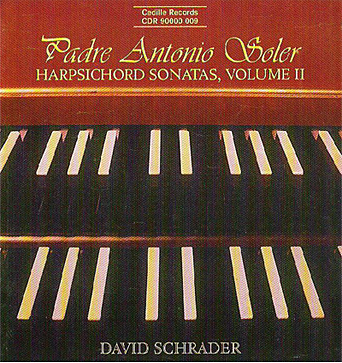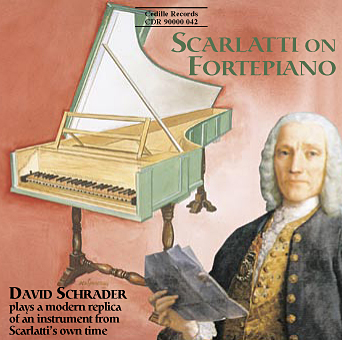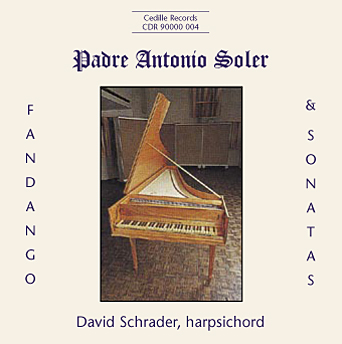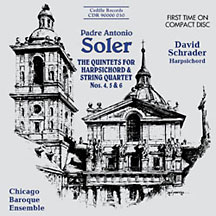| Subtotal | $12.00 |
|---|---|
| Tax | $1.23 |
| Total | $13.23 |
Store

Store
Padre Antonio Soler: Harpsichord Sonatas – Volume ll
David Schrader concludes his selective, two-part survey of Antonio Soler’s imaginative harpsichord sonatas with a CD of witty pieces that elicit smiles and others that bring to mind a wealth of instrumental timbres, most notably Spanish guitar and baroque trumpet flourishes.
Schrader plays vivaciously; his readings sparkle with freshness and immediacy that make these 200-year-old pieces seem almost new. This disc includes nine sonatas, with the cheery, quasi-classical, four-movement Sonata No. 62 flanked by pieces in conventional Baroque single-movement form.
In the liner notes, Schrader writes of Soler’s musical humor, at one point conjuring the image of the composer “snickering” as keyboard players careen through Sonata No. 10’s devilishly difficult passages. (The sonata calls to mind cartoon-like-cat-and-mouse escapes, carnival calliopes, tubas, and melodramatic piano tracks for silent movies — although no one claims Soler was that prescient.) Schrader says historical evidence indicates Spanish royalty and clergy did have a sense of humor (the Inquisition notwithstanding).
Many of Soler’s later sonatas show the emergence of the Classical age, but Sonata No. 81, with its sudden contrasts, prefigures even Romantic forms, The exhilaration the listener senses in the music might well relate to the thrill of venturing beyond old barriers.
Although a Spanish quality permeates Soler’s music in general, the leisurely paced Sonata No. 74 takes this association to another level: it’s written (and performed) in a way that make the harpsichord sound uncannily like a guitar. Particularly colorful, this sonata also evokes trumpet fanfares in coda-like passages.
Preview Excerpts
PADRE ANTONIO SOLER (1729-1783)
Sonata No. 62 in B-flat major
Artists
Program Notes
Download Album BookletPadre Antonio Soler: Harpsichord Sonatas, Volume ll
Notes by David Schrader
Although Padre Antonio Soler composed many medium and large-scale works for the church and other venues, he is best known for his keyboard sonatas. These highly varied works occupy a central position in Soler’s oeuvre and represent a unique contribution to the repertoire for harpsichord, organ, and fortepiano.
Antonio Francisco Javier Jose Soler y Ramos was baptized on December 3, 1729. Destined for a career in the church, in 1736 he entered the choir school of the great Catalan monastery of Montserrat, where he studied with the monastery’s “Maestro,” Benito Esteve, and its organist, Benito Valls. After becoming maestro de capilla at Lerida circa 1750, Soler was ordained to the subdiaconate in 1752. He entered the Hieronimite monastery at El Escorial, the large palace and college cum monastery established a century and a half earlier by King Philip II, taking the habit on September 25, 1752. Soler became maestro de capilla at El Escorial in 1757, upon the death of the incumbent maestro, Domenico Scarlatti. The monastery’s extant records, or actos capitulares, note that Soler had an excellent command of Latin, organ playing, and musical composition, and that his conduct and application to his discipline were exemplary.
Soler is known for his theoretical writings, which, in addition to the famous Llave de le modulacion (key to modulation) of 1762, even include a treatise on the conversion rates between Catalan and Castilian currencies. While the principles contained in the Llave are still recognized as valid, it is well to note that the modulations were considered radical enough in eighteenth century Spain to elicit critical rebuttal, to which Soler himself responded with a 1765 tract entitled Satisfacción a los reparos precisos (reply to specific objections).
Like his illustrious predecessor at the Spanish court, Soler also enjoyed the patronage of a member of the royal family, Prince Gabriel, the son of Charles III. Soler wrote many of his sonatas for the prince, who also inspired Soler’s Six Concerti for Two Organs and his quintets for keyboard and strings. While Scarlatti’s influence on Soler is evident, salient differences exist in the two composers’ works for keyboard. Soler composed more sonatas in a relatively moderate tempo than did Scarlatti; the acciaccaturas (dissonant notes played quickly in between harmonic tones of chords, literally “the crushed ones”) so germane to Scarlatti’s musical language rarely appear in Soler’s keyboard works; and Soler made frequent use of Alberti bass patterns, which Scarlatti tended to avoid. Similarities, however, include the demand for virtuosic technique, a fondness for syncopations, and a thorough infusion of Spanish folk music.
Soler’s music spans two eras. Born during the latter part of the baroque period, Soler lived to compose music reflective of a later tradition. Eight of the sonatas on this recording are of the single-movement design favored by Scarlatti. The one multi-movement work represents an unusual assimilation of the classical style.
Unlike the graceful, sensuous idiom cultivated by the French clavecinistes, the music of Soler, whether in a moderate or a quick tempo, gives an immediate impression of urgency and vigor. Composed of an elaborate linkage of cadential formulas, Soler’s pieces abound with changes of texture, extremes of range, and all types of virtuosity in which both player and listener are meant to take delight.
The harmonic design of the two-part, one-movement sonatas is fairly uniform: if the sonata is in a major key, the first half will progress from tonic to dominant. If the work’s tonality is minor, the first half will lead to the relative major, and the second half will return to the tonic. Yet the variety of ways in which Soler treats this familiar formula is astounding. Most notable in the A major Sonata that opens this record are the fanfares at the work’s outset and the many repeated notes that flicker throughout the second half. The Sonata No. 2 in E-flat is characterized by trills and thirds in the right hand, and athletic leaps in the left. Although the third sonata is in a more moderate tempo and has none of the virtuosic romps of its two predecessors, it still conveys a sense of inexorable forward motion. The clever linking of phrases allows for no moment of repose despite the tempo indication of Andante.
The eighth sonata in C major introduces a new dimension to this recording — that of the terrace dynamics available to instruments with two keyboards. Although the eighth sonata is more sectional than the third, its interplay of different dynamic levels lends variety and interest. The raised neighbor tones of the secondary theme and the general regularity of the phrases creates a listening experience that the Italians would call a “piacevole.”
With the Sonata No. 10 in B minor, however, the world of driven, intense virtuosity returns with a vengeance! The chief demand on the player is that of passing the left hand quickly over the right in a veritable fusillade of passages that would beggar the most exacting target practice of a veteran skeet-shoot. When storms of trills and rapid, cascading runs are added to this already formidable docket, one can only imagine the specter of Soler snickering at the challenged performer, simultaneously manufacturing perspiration while in search of expression. The scope of the piece is of surprisingly large dimension, however, and the effect of dark intensity it produces well repays the efforts of the player.
The four-movement plan of the Sonata No. 62 in B-flat is clearly a mark of the emerging classical period and esthetic, but the forms of the individual movements themselves is not at all in keeping with the tradition we have come to expect from better-known composers of the late 18th century. Despite the generous length of this sonata, the content of each movement is lightweight, and the outer movements are quite eccentric. The humorous first movement is cast not in sonata-allegro form, but as a rondo — a form generally associated with final movements of classical sonatas. The second and fourth movements are cast in the binary form of the one-movement sonatas. Only the third movement, a minuet, seems to have found its proper place as a component of a classical sonata. The finale departs from Soler’s usual harmonic scheme: instead of the dominant, F major, the harmony arrived at toward the end of the first half is in the minor key of the mediant, D minor. The transparency of texture and the graciousness of motion inherent in all four movements could well have become mired in convention had those movements (especially the outer ones) been cast in the standard classical forms. The keyboard writing and form of each movement are sufficiently out of the ordinary to ensure intrigued listening over many hearings.
The 70th and 74th sonatas return us to the single-movement format. Each is a perfect foil for the other. No. 70 is characterized by a headlong virtuosic drive, while the dignified No. 74 presents arresting harmonic progressions, and lots of cesurae (pauses) so the listener can savor the unusual harmonies.
The last sonata on the recording, No. 81 in G minor, is like two completely different pieces smashed together into one schizophrenic sonata. As the harmony moves from the tonic to the expected relative major, the tempo suddenly shifts from the beginning’s wild prestissimo to an impassioned cantabile. The rest of the sonata is something of a pitched argument between these very different characters that is at once fascinating, passionate, and complete. While one does not speak of classical Sturm und Drang in Spanish music, the idea does not seem impossible here.
As with my first recording of Soler, the changes in accidentals that I supply periodically throughout the disc are in accordance with performance practice applicable to the rendering of 18th century Spanish keyboard music. Repeated passages are apt to be slightly embellished.
The instrument used in this recording is a double-manual harpsichord built by Lawrence G. Eckstein of West Lafayette, Indiana in 1983. It is based on the Dumont-Taskin harpsichord which is kept in the museum of the Conservatoire National de Paris. It has two sets of unison-pitched strings and one set tuned an octave higher. Extensive work on the instrument’s action was carried out by Paul Y. Irvin. The harpsichord is tuned to A=415 Hz, and the temperament used is similar to that devised by Thomas Young (c. 1800).
Album Details
Total Time: 75:58
Recorded: September 6 & 7, 1991 at WFMT Chicago
Producer: James Ginsburg
Engineer: Bill Maylone
Front Cover Photo: Erik S. Lieber
Design: Robert J. Salm
Notes: David Schrader
© 1992 Cedille Records/Cedille Chicago
CDR 90000 009


